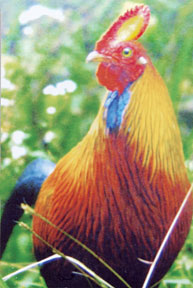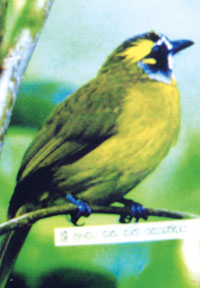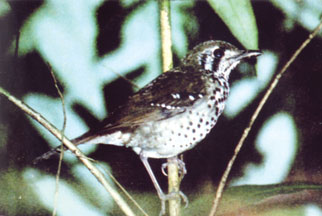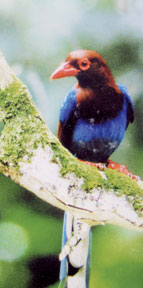Sinharaja - the birders' heritage
by K. G. H. Munidasa

Ceylon Rufous Babbler |

Ceylon Yellow-eared Bulbul |

Ceylon Junglefowl (cock) |

Ceylon Grey Hornbill |
| |
 |
| Spotted-winged
Thrush |
Sinharaja, A World Heritage site since 1988 is probably the most
important site in Sri Lanka for its biodiversity. The reserve
encompasses some of the few remaining sizable tracts of undisturbed
primary lowland rainforests, though much of it has been subjected to
selective logging, in the recent past.
Covering an extent of approximately 11,187 ha. Sinharaja Forest was
initially declared a Wilderness Area under the National Heritage
Wilderness Area Act of 1988, and subsequently a World Heritage Site in
1989, being the first natural resource in Sri Lanka to earn that
distinction.
The natural vegetation of Sinharaja has been identified as related to
that of humid wet evergreen type, with a high degree of endemism. Out of
the 211 woody trees and lianas so far identified within the reserve 139
or 66 percent are endemic to the island.
The preliminary studies on the fauna of Sinharaja have revealed a
high degree of endemism among the animal-life, which occur within the
boundaries of the reserve. In fact, 95 per cent of the endemic birds of
Sri Lanka are recorded there. Endemism among mammals and butterflies is
also greater than 50 per cent.
A survey report by Extension Service of the Forest Department has,
among other aspects, disclosed in reference to the bird-watching
potentials in Sinharaja as follows: "One of the most interesting and
colourful spectacles to be found in the Sinharaja is the presence of
mixed species of foraging bird flocks, a phenomenon commonly found in
rain forests.
A total of 100 such flocks were systematically observed, and studies
have revealed that some of these flocks contained 48 species, including
12 endemic species.
The rare endemic birds to be seen in Sinharaja are the Red-Faced
Malkoha, the Sri Lanka Blue Magpie, the Ashy-headed Babbler, the
White-headed Starling and the Green-billed Coucal, the rarest of the Sri
Lankan birds."
In February 1992, a party of British and American birders spent two
days in the Sinharaja, under the guidance of the world-renowned
Ornithologist Dr. Ben F. King. During the visit they recorded a typical
flock that consisted of Rufous Babbler, Ashy-headed Babbler, Red-Faced
Malkoha, Trogon, Layard's Parakeet, Lorikeet, Crested Drongo,
Yellow-Fronted Barbet, Black-capped Bulbul and Legge's Flowerpecker.

Ceylon Blue Magpie |

Green-Billed Coucal |
The party saw quite a number of the Green-billed Coucal, though they
failed to find any bamboo groves around the place. On information given
by a worker they observed one particular coucal for about 15 minutes
busy collecting nesting material in a Pandanus plant. They also noted
two more previously unrecorded calls of the Green-billed Coucal.
One of these was an astonishing cough-like sound, which one would not
ever associate with a coucal. The other was a soft owl-like, two-tone
hooo, with a short first hoo, somewhat like the call of the Ceylon
Fish-Owl. Both these calls seemed to be way of communication between the
male and female of the pair.
In a note submitted to the Ceylon Bird Club, Dr. King was definite
that there could be 24 endemic bird species in Sri Lanka, three more
than the generally accepted 21.
He proposed the three species as the Grey Hornbill Tockus gingalensis,
the Chestnut-backed Owlet Glaucidium castananotum, and the Small Barbet
Megalima rubricapilla. He had expressed the view that there were
sufficient characteristics both in vocalisation and colour patterns to
recognise them as good species and no longer as mere sub-species.
He had also emphasised that the number of endemic species in Sri
Lanka could rise to as many as 30 if appropriate studies could be
carried out by competent experts; two of the likely candidates being the
Black-headed Bulbul Pycnono melanicterus, and the Hill Swallow Hirundo
tahitica.
From September, October and November 1993 visitors to the forest
reserve had come across mixed feeding flocks as mentioned before.
During these three months teams from the Ceylon Bird Club had
encountered roving feeding flocks in the reserve that comprised endemic
species such as the Red-Faced Malkoha, Chestnut-baked Owlet, Ceylon
Frogmouth, Ceylon Blue Magpie, Spotted-winged Thrush, Ceylon Hill Mynah,
White-headed Starling, Rufous Babbler, Ceylon Crested Drongo, Legge's
Flowerpecker, Yellow-browed Bulbul, Black-capped Bulbul, Green-billed
Coucal, Ceylon Trogon, Ceylon Hill White-Eye and Lesser Yellow-naped
Woodpecker. In late November a similar large flock recorded in the
reserve comprised 50 different species, out of which 14 were endemics.
In February 1994, a Green-billed Coucal was noted making a call
described as a short, soft 'hoo', repeated at intervals. Apart from the
common wet zone species several White-headed Starlings, five
Spotted-winged Thrush, Seven Ceylon Trogons, two Ceylon Spurfowl, 12
Legge's Flowerpeckers, and two Ashy-headed Babblers were the endemics
observed. Then in October/November the Leyard's Parakeet, Ceylon
Lorikeet, Yellow-fronted Barbet, Ceylon Wood Pigeon and Ceylon
Scimitar-Babbler were also recorded. A female Ceylon Spurfowl observed
near the Research Centre, was accompanied by a chick.
In February, 1995 CBC has reported the discovery of a nest of the
Red-faced Malkoha in the canopy of a tall tree, beside the road. The
nest was about 60 feet above the ground, and one of the pair was
incubating. On the same day a nest of the Ceylon Blue Magpie was also
detected in a very small tree about 15 feet above the ground, and one of
the pair was sitting.
On August 12, the same year, four Broad-billed Rollers were sighted
in the reserve after a long time, and on Novembers , a flock of the
Ceylon Spurfowl was observed near a rubbish dump at the Research Centre.
On 1-2 March, 1996, a team from the "Signus" bird-watching group of
England paid their annual visit to Sri Lanka on a birding tour,
sponsored by the Ceylon Bird Club. During their visit to Sinharaja,
among the usual Wet Zone birds, they observed 4 Ceylon Wood-pigeons, six
Ceylon Hill Mynahs, four Layard's Parakeets, eight Ceylon Hill Munias,
four Ceylon Trogons, two Red-Faced Malkohas, one Green-billed Coucal,
two Ceylon Spurfowl, two Spotted-winged Thrushes and a plenty of Rufous
Babblers and Ashy-headed Laughing Thrushes.
In September, 1997 a nest and a fledgeling of the Green-billed Coucal
were observed on the Mulawella trail, outside the main forest.
The nest was placed within the crown of a small tree covered with
creepers, situated close to the trail and a rushing stream, among thick
bamboo growth. It was about 10-12 feet above ground, and easily seen as
it was not properly hidden in the foliage.
The young caucal had by then left the nest and was waiting in a
nearby bush. Its tail was very short and the beak black in colour, thus
it could have been very easily taken fir a young of the Common Coucal.
However, a bit of purplish sheen on its neck suggested that it was not
of the latter species. In about an hour later, its specific identity was
confirmed when a parent Green-billed Coucal came round and fed the young
bird.
According to CBC sources, in February, 1998, a flock of six Red-faced
Malkohas were noticed preening themselves and drying their wings on top
of a tree, after the precious night's downpour, allowing a very close
approach.
Following May, two pairs of Blue Magpies, each with a fully-fledged
young, were observed. The young birds, which could fly well, had rather
smaller beaks. Their colour too, was duller-particular on the underparts-than
in the adults, and they lacked the red orbital ring around the eye.
On August 7, the same year, a pair of the Ceylon Hill Munia was
building a nest, about 30 feet above the ground, in a tree close to a
paddy field, at the entrance to the forest reserve. Towards the evening
about 60 Hill Munias were noticed feeding in a small paddy field by the
side of the road near Veddagala. They moved here and there in small
groups, varying from about six to ten individuals in each.
It is desirable that everyone who visits the Sinharaja forest to be
sensitive to the need to conserve the forests, in general. Contrary to
the chaos and congestion prevailing in the urban areas, it is in the
forests that the quality of life is best expressed, where Man finds
peace and tranquillity.
Allow yourself sufficient time to roam about this nature's cathedral
that is Sinharaja, and enjoy its beauty, serenity and majesty, whether
you are a scientist, scholar or an ordinary lover of nature. |

